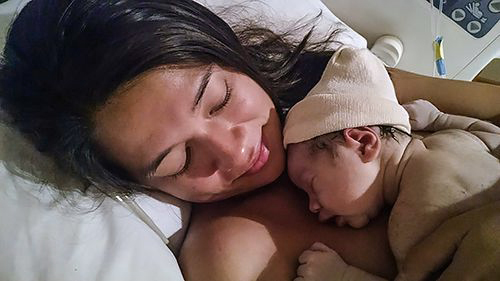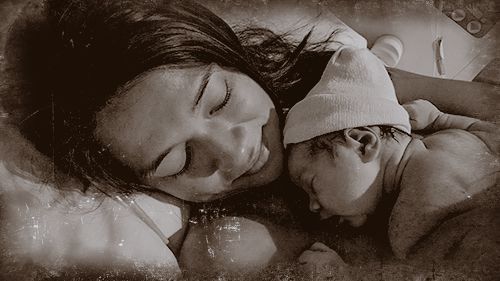Photo Corners headlinesarchivemikepasini.com
![]()
A S C R A P B O O K O F S O L U T I O N S F O R T H E P H O T O G R A P H E R
![]()
Enhancing the enjoyment of taking pictures with news that matters, features that entertain and images that delight. Published frequently.
Tintypes In The Digital Age




6 October 2015
We've been wondering why we're seeing so many modern photographers devote themselves to the wet collodion process. After all, it's the digital age. What are these people doing fooling around with chemicals?
We are no doubt missing the point. In fact, it could be that the reason for wet collodion's popularity is the digital age itself. It is, unquestionably, the antithesis of digital.
OR IS IT?
But we don't think it would be nearly as popular if it weren't for the digital age. One trouble with wet collodion is the chemistry but the other is that you only get one copy of the image. Like Polariods.

Mom & Cora. Smartphone shots are the Polaroids of the digital age.
But here in the digital age, we can scan those one-offs and reproduce them as effortlessly as if they were digital images to begin with.
So, you know, the investment isn't lost when the plate disappears.
And yet, being a student of efficiency, we couldn't help but wonder if there wasn't an easier way to get from the studio to the scan. One in which the smell of chemicals can be avoided.
Of course there is.
You can turn any image into a tintype with nothing more than a filter in your image editing software. We happen to be fond of Exposure 7 for this sort of thing and sure enough it has a few tintype effects.
THE TINTYPE
What exactly is a tintype effect? And why are we calling wet collodions tintypes all of a suddent?
Well, the process is that a support of glass (ambrotype) or tin (tintype) is coated by a liquid emulsion that is slipped into a camera after it dries. The exposure makes a negative image that appears like a positive thanks to the dark background (which has to be added to an ambrotype, hence our leap to tintype whose metal does that job all by itself).
Because these emulsions were applied by hand (tilting the glass or metal until the liquid coats it evenly and then pouring the excess back into the bottle), they were imperfect. That's part of their anti-digital charm.
And, of course, they were monochrome.
A SUBJECT
For a subject, we hunted around for an already imperfect monochrome image to turn into a simulated tintype.
At first, we thought this approach would be perfect for a memorial photo of a recently departed friend who had hated to have her photo taken so much that the only decent one we had of her was taken surreptitiously when she was surrounded by empty dinner plates. It was not a well-lit room so she was a bit soft. A flattering shot, frankly. But not perfect, making it, um, ideal.
We gave it a try but immediately realized the problem. She wasn't old enough to have lived in the 1800s, we could hear her scolding us from her urn.
Some people, alas, will do anything to avoid having their picture seen.
As we were making peace with our departed friend, we were fortunately rescued by fate itself in a friendlier guise. A particularly handsome nephew with an absolutely beautiful wife texted us a photo of his wife and brand new daughter Cora.
You may remember them from their wedding. Time flies.
You are never too young to be Photoshopped and as the Great Uncle in charge of the mouse, it was up to me, apparently. Besides it was a lovely image.
IMAGE REPAIR
We'll guess it was a Samsung smartphone image. Since it was texted to us, we didn't have any Exif data to tell us.
Problem one was that the fluorescent hospital lighting gave an greenish cast to the scene. You can see it on the white pillow, for example, in the image below. Sampling that pillow, though, only partially removed the case.

We knew better (from long stints in hospitals) but we sampled the bed siding anyway. It's not white. It's beige. If you're lucky.
But that gave a ruddy glow to the scene, eliminating any greenish cast. Hurray. We only had to shift things a bit toward the warm end of the spectrum and away from blue to bring a touch of reality back. And we cut the Saturation a bit (oh, those smartphone JPEGs).
Why were we doing this if all we wanted was a monochrome image?
Ah, but this is the digital age. All we wanted was everything. A variety of options, starting with decent color.
We opened up the shadows a bit to get some detail in Mom's dark hair (oh dear, she's a Mom now). But the highlights were fine. (Yes, we cranked up the Clarity a good bit. We always do.)
Then we were ready for the filter.
TINTYPED PLUS
We sent the full-resolution image to the Exposure 7 plug-in and selected the Vintage - Wet Plate effect based on Black & White films. That was a bit pedestrian for the new beauty in the family. So we took a look at the Split Toning options in the right panel and selected Selenium Warm/Cool.
We set the color to a brown at half strength for something like a sepia print. Which would not have been possible with a real tintype. Ah ha! Just the ticket.

The filter did its damage to the surface of the print, especially along the edges. But not well enough for our sensitivities.
So we changed the border to Damaged 7, which did not have corners. It also didn't have much damage. So we enabled Texture to add Scratches 6, which had the virtue of leaving the faces alone.
We hewed to one historical effect. No grain. You wouldn't have seen grain in a tintype. And so we didn't add it.
We were done.
Except that, in the digital age, you are never done. There's always something else you can try.
In this case it was simply to restore a hint of color. Again, not historically possible. But those old coots would have done it if it were. So, being an old coot ourselves in the digital age, we gave it a shot.
We set the tintype layer in Photoshop to just 50 percent. Then we adjusted Levels on that layer to bring back some of the grunge we lost by reducing the opacity.
Lovely! Angelic!
(Now that you've come into the world with a fashionable tintype simulation, Cora, don't forget to send us that signed model release as soon as you learn to write your name in pre-school.)
CONCLUSION
We don't think these wet collodion photographers would have nearly the enthusiasm for the process were it not for being able to scan the plates in the digital age.
But you can get the same effect with nothing more than a clever filter. And if it's really clever, you can tweak it with more distressed borders and scratches than a century of handling would contribute.
Even better, though, you can take the image into a new realm by restoring a touch of color. And why not? It's really the best of both worlds.